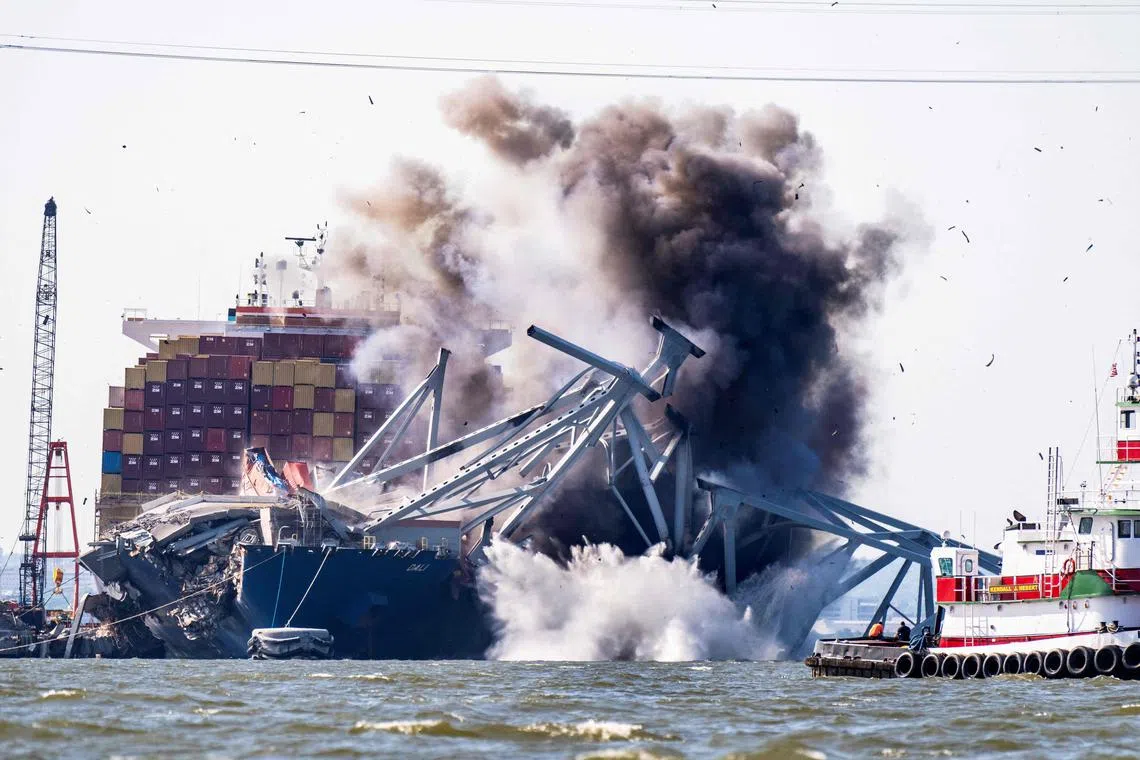MPA probes engine breakdown on S’pore-flagged sister ship of Dali vessel that struck US bridge
Sign up now: Get ST's newsletters delivered to your inbox

A controlled demolition being conducted on a section of Baltimore's Francis Scott Key Bridge, resting on the MV Dali, in May 2024.
PHOTO: AFP
Follow topic:
SINGAPORE - The Maritime and Port Authority (MPA) of Singapore is investigating an incident involving engine issues on Singapore-flagged container ship Maersk Saltoro that broke down on its way to China, delaying the delivery of a multimillion-dollar cargo load of Chilean cherries.
The incident spotlights Singapore’s maritime safety laws, crew qualifications and the risks seafarers face – coming as it does after the MV Dali, also Singapore-registered, crashed into Baltimore’s Francis Scott Key Bridge in March 2024.
An MPA spokesperson told The Straits Times that Singapore adheres to internationally recognised maritime safety standards, ensuring ships are properly built, equipped and operated. Seafarers must be well trained and ship management must follow structured safety procedures.
As the flag administration for Singapore-registered ships, MPA conducts regular inspections and works with eight leading international classification societies to ensure compliance.
“As the flag state, MPA is investigating the reported machinery fault on board the Maersk Saltoro,” it said.
On Jan 13, the Maersk Saltoro suffered a main engine breakdown in the Pacific Ocean, 17 days into its 24-day voyage on the shipping line’s “Cherry Express”. The service, which runs during the peak cherry export season from November to February, transports highly perishable cherries from Chile to Asia, mainly China, ensuring swift delivery.
The vessel resumed its voyage on Feb 4 after repairs were completed, and is now expected to arrive at Nansha port in Guangzhou on Feb 17, subject to weather conditions, according to Maersk.
The ship, which is carrying 1,353 containers of cherries, or 24,000 tonnes, was originally scheduled to arrive in time for Chinese New Year on Jan 29.
The Maersk Saltoro is owned by Singapore-incorporated Argosy and operates under the Singapore flag. It is managed by Synergy Marine, the same firm overseeing the MV Dali when it crashed into the Baltimore bridge.
Fellow Singapore company Grace Ocean, owner of the MV Dali, and Synergy Marine have since agreed to pay nearly US$102 million (S$137.6 million) to settle a US civil lawsuit over the bridge collapse.
The Maersk Saltoro is a sister ship to the MV Dali, meaning they are of the same design. Like the Dali, it was built by South Korean company Hyundai in 2015 and measures 300m long and 48m wide.
“We cannot speculate at this time as to whether there are any common factors between this incident and that involving the MV Dali,” a spokesman for shipping giant Maersk told ST on Feb 11.
Synergy Marine’s head of communications Vishal Srivastava said the Maersk Saltoro undergoes regular maintenance, inspections and compliance checks.
He noted that the ship passed Chilean inspections with no deficiencies before departure and has a strong Port State Control (PSC) record. PSC inspections ensure that foreign ships in a country’s port comply with international safety, security and environmental standards.
“Cargo vessels, like any complex mechanical assets, may experience technical issues from time to time,” he said.
Mr Srivastava added that technicians from the engine manufacturer and Synergy Marine are on board to assess performance and ensure continued safe operations. A full internal review is also under way to enhance preventive measures.
He confirmed that the crew remain safe and well supported, with sufficient food and provisions and uninterrupted satellite communication, including Starlink Wi-Fi.
Essential systems, such as air-conditioning, have remained fully operational.
The incident could also set costly insurance precedents for shipments of high-value perishable products on container ships, according to S&P Global’s Journal of Commerce (JOC).
Cargo insurance broker Fester & Co told JOC that perishable cargo is covered by insurance, estimating the total cost of the cherries on board at around US$60 million. However, shippers may argue that if the cherries had arrived on time, their value could have been three to four times higher.
Responding to ST, Maersk confirmed that temporary repairs on the vessel have been successfully completed. “Meanwhile, the vessel owners have confirmed that all on-board reefer containers are plugged in and on power,” said a spokesman.
It is unclear whether these refrigerated containers were powered when the engine had issues between Jan 13 and Feb 4.
“We are maintaining close communication with the vessel owners to track the status and are keeping the affected customers updated on the progress,” the spokesperson added.
When asked if Maersk would re-evaluate its contract with Synergy Marine given the two mechanical failures, Maersk clarified that it does not have a direct contract with Synergy Marine. Instead, its contract is with Argosy, which in turn has a contract with Synergy Marine.
“Maersk is committed to partnering with responsible vessel owners and we work closely with these owners and their respective managers to ensure they adhere to all safety and operational standards,” its spokesperson said.
“Our continuing efforts and focus remain with our customers to address and mitigate the issues they are facing as a result of this incident.”
Kang Wan Chern is deputy business editor at The Straits Times.

